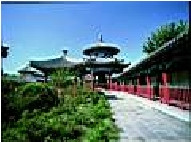 During the Ming and Qing dynasties, the emperor came to the Temple of Heaven to pay homage to Heaven. The custom to worship Heaven and the earth came into being during the Zhou Dynasty (c. 11th century - 256 B.C.) and elaborated into a formal ritual during the Han and Tang dynasties (618 - 907). In the early 15th century a temple was built to pay respect to both heaven and the earth and in the middle of that century the ceremonies to worship heaven, the earth, the sun and the moon were conducted at four seperate temples. The Temple of Heaven was expanded during the Qing Dynasty and has remained as the largest complex of temple in China. During the Ming and Qing dynasties, the emperor came to the Temple of Heaven to pay homage to Heaven. The custom to worship Heaven and the earth came into being during the Zhou Dynasty (c. 11th century - 256 B.C.) and elaborated into a formal ritual during the Han and Tang dynasties (618 - 907). In the early 15th century a temple was built to pay respect to both heaven and the earth and in the middle of that century the ceremonies to worship heaven, the earth, the sun and the moon were conducted at four seperate temples. The Temple of Heaven was expanded during the Qing Dynasty and has remained as the largest complex of temple in China.
The Temple of Heaven has an area of 273 hectares with a layout in two squares one inside the other. Two walls divide the ground into the outer and inner parts. The outer wall is 6, 416 meters long and the inner wall is 3, 292 meters long. The northern part of the outer and inner walls is a semicircle and the southern part of them is square, declining from north to south to symbolize the traditional belief that Heaven was high and round and the earth was low and rectangular. Main structures are located on the ends of a flagstonepaved central north-south path: from south to north are the Circular Mound Altar, Imperial Vault of Heaven, the Hall of Prayer for Good Harvest and Huangqian Hall. Auxiliary structures include Divine Kitchen, Slaughter Pavilion and Palace of Abstinence.
The Temple of Heaven is an outstanding representative of Chinese traditional architecture for its clever design and harmoneous colors.
Inside the Hall of Prayer for Good Harvest
The pillars inside the hall all have a meaning: the four in the inner circle represent the four seasons of the year; the 12 pillars in the middle circle represent 12 months of the year and the 12 pillars in the outer circle represent 12 time periods of the day. The Leigong Pillar under the center of the ceiling means the absolute power of the emperor.
Echo Wall
The circular wall surrounding the Imperial Vault of Heaven is 193.2 meters long, 3.7 meters high and 0.9 meter thick. If one speaks against the wall at one end another can hear his voice at other end of it.
Three-Echoes Stone
It is the third stone slab on the path in front of the Imperial Vault of Heaven. When one stands on it and claps his hands three or more echoes seem to emit from the stone. It can cause such echoes because it is located in the middle under the Echo Wall. It was made mysterious in the old days by the rulers to prevent gossiping against them.
Circular Mound Altar
Also known Heaven Mound Altar, it is five meters high and of three tiers. Around each tier there are white marble balusters. During the Ming and Qing dynasties in early winter the emperor would come to this mound to pay homage to heaven and pray for peace and a good harvest.
|